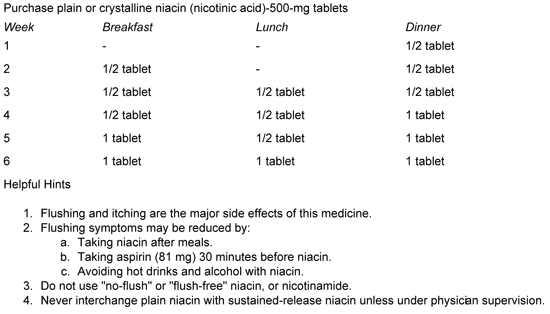
Am Fam Physician. 2004;70(5):956-958
Nicotinic acid, or vitamin B3, was used as early as 1955 to treat dyslipidemia. Daily dosages of 1,000 to 4,000 mg have been shown to lower triglyceride levels by 20 to 50 percent and low-density lipoprotein cholesterol levels by 10 to 25 percent, and to increase high-density lipoprotein (HDL) cholesterol levels by 10 to 30 percent. In the Coronary Drug Project (1969 to 1975), documented nicotinic acid therapy for six years reduced the frequency of nonfatal myocardial infarction compared with placebo. When combined with a bile-acid sequestrant or a statin, nicotinic acid therapy resulted in angiographic regression of atherosclerosis and fewer cardiovascular events.
Side effects, however, have limited the use of nicotinic acid; patients taking low dosages report cutaneous symptoms with flushing episodes that seem to decrease with continued use. Other reported side effects include hepatotoxicity, insulin resistance, hyperglycemia, and hyperuricemia.
The variety of preparations and the irregularity of nicotinic acid content in over-the-counter supplements not controlled by the U.S. Food and Drug Administration (FDA) make the choice of an effective preparation difficult. Meyers and associates looked at over-the-counter niacin preparations to determine the cost and the content of free nicotinic acid.
Three categories of preparations are available: (1) immediate-release niacin, which is absorbed within one hour of ingestion, (2) sustained-release niacin, which is absorbed over several hours, and (3) no-flush niacin. Multiple brands advertised as containing 500 mg of niacin were studied. A monthly cost for a daily 2,000-mg dose was calculated for each preparation. Total nicotinic acid content was determined using liquid chromatography.
The monthly costs varied widely; no-flush preparations were the most expensive. Free nicotinic acid content was close to 500 mg per pill in the immediate- and sustained-release preparations. The no-flush preparations contained no detectable free nicotinic acid but did contain an ester of nicotinic acid called inositol hexaniacinate, which is thought to release nicotinic acid without causing flushing in animals. However, little free nicotinic acid is released, and plasma nicotinic acid levels reach only about one tenth of the levels achieved with immediate preparations of equal dosage. Sustained-release niacin causes less flushing but may result in more hepatotoxicity. There are some favorable published data about two specific brands of sustained release preparations, Slo-Niacin and Enduracin. Niaspan, approved by the FDA, is effective and provokes less flushing but is more expensive than immediate-release preparations. Immediate-release preparations are inexpensive and have been demonstrated to reduce cardiovascular events and death.

The authors conclude that some over-the-counter niacin preparations, including no-flush preparations, contain no free nicotinic acid. Because immediate-release preparations are the least expensive and are supported by the most data, it is recommended that therapy begin with 250 mg of immediate-release niacin taken after dinner for one week and that the dosage be adjusted upward to 500 mg three times daily within six weeks. Flushing can be reduced by several simple maneuvers(see accompanying figure). Glucose, liver transaminase levels, and uric acid levels should be monitored during the adjustment period.
editor’s note: Niacin was used as early as 1955 to treat dyslipidemia. Beneficial actions include decreased levels of triglycerides and apolipoprotein-B, increased HDL levels, and increased cardioprotective subfraction of HDL cholesterol in patients with low HDL levels. These actions make niacin, taken alone or in combination, a useful treatment to prevent progression and promote regression of coronary atherogenic lesions and significantly reduce coronary artery disease–related morbidity and mortality. Combination therapy with statins or bile-acid sequestrants may better resolve the full spectrum of lipid abnormalities in some patients. Because niacin may adversely affect glucose and insulin sensitivity, candidates for treatment should be carefully selected.—r.s.